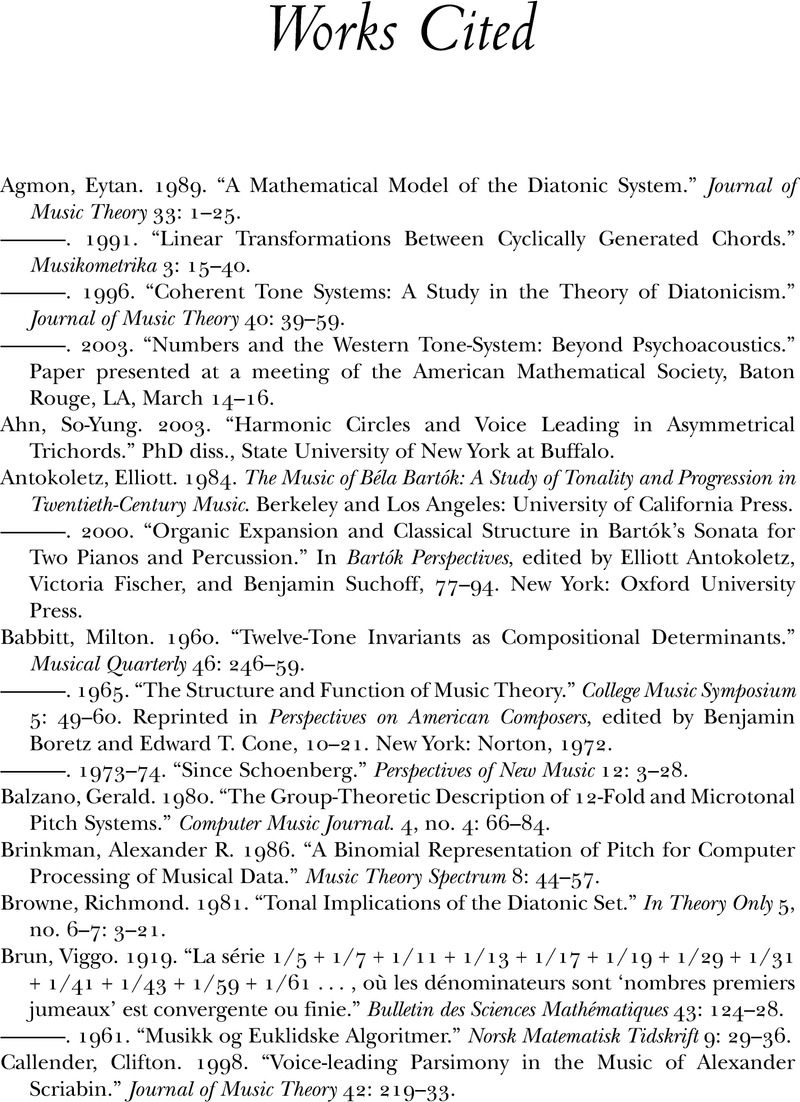Book contents
- Frontmatter
- Contents
- Preface
- Introduction
- 1 “Cardinality Equals Variety for Chords” in Well-Formed Scales, with a Note on the Twin Primes Conjecture
- 2 Flip-Flop Circles and Their Groups
- 3 Pitch-Time Analogies and Transformations in Bartók's Sonata for Two Pianos and Percussion
- 4 Filtered Point-Symmetry and Dynamical Voice-Leading
- 5 The “Over-Determined” Triad as a Source of Discord: Nascent Groups and the Emergent Chromatic Tonality in Nineteenth-Century German Harmonic Theory
- 6 Signature Transformations
- 7 Some Pedagogical Implications of Diatonic and Neo-Riemannian Theory
- 8 A Parsimony Metric for Diatonic Sequences
- 9 Transformational Considerations in Schoenberg’s Opus 23, Number 3
- 10 Transformational Etudes:Basic Principles and Applications of Interval String Theory
- Works Cited
- List of Contributors
- Index
- Miscellaneous Frontmatter
Works Cited
Published online by Cambridge University Press: 10 March 2023
- Frontmatter
- Contents
- Preface
- Introduction
- 1 “Cardinality Equals Variety for Chords” in Well-Formed Scales, with a Note on the Twin Primes Conjecture
- 2 Flip-Flop Circles and Their Groups
- 3 Pitch-Time Analogies and Transformations in Bartók's Sonata for Two Pianos and Percussion
- 4 Filtered Point-Symmetry and Dynamical Voice-Leading
- 5 The “Over-Determined” Triad as a Source of Discord: Nascent Groups and the Emergent Chromatic Tonality in Nineteenth-Century German Harmonic Theory
- 6 Signature Transformations
- 7 Some Pedagogical Implications of Diatonic and Neo-Riemannian Theory
- 8 A Parsimony Metric for Diatonic Sequences
- 9 Transformational Considerations in Schoenberg’s Opus 23, Number 3
- 10 Transformational Etudes:Basic Principles and Applications of Interval String Theory
- Works Cited
- List of Contributors
- Index
- Miscellaneous Frontmatter
Summary

- Type
- Chapter
- Information
- Music Theory and MathematicsChords, Collections, and Transformations, pp. 245 - 252Publisher: Boydell & BrewerPrint publication year: 2008

